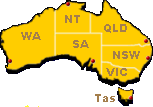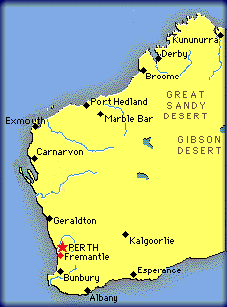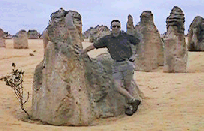The first time I visited
Australia (the East-coast in 1992) I thought that it was a
combination of an American exterior (appearance, commercial,
extroverted) and an English interior (tradition, values,
culture). Now while actually living in the country I find more
and more that Australia has its own distinct features.
Of course you can never
generalise and within Australia Perth has a different lifestyle
again. Probably as it is one of the loneliest cities in the
world. The nearest city is Adelaide at almost 3.000 kilometres.
This and the Mediterranean climate makes things less hectic, in
fact rather relaxed.
Perth, Western
Australia
 Australia's largest state, Western
Australia, comprises a third of the landmass of the
continent. It stretches from the tropical shores of the
Timor Sea in the north, down the Indian Ocean coastline
to the wild coastline of the south-west region washed by
the Southern Ocean. Australia's largest state, Western
Australia, comprises a third of the landmass of the
continent. It stretches from the tropical shores of the
Timor Sea in the north, down the Indian Ocean coastline
to the wild coastline of the south-west region washed by
the Southern Ocean.The first known Europeans to land on
the coast of Western Australia were Dirk Hartog and
his Dutch crew from the ship Eendracht. They landed
in 1616, on the island which now bears Dirk Hartog's name
in Shark Bay. Throughout the 17th century,
many Dutch navigators on the sea route from Holland to
Indonesia touched the Australian coast, usually after
being blown off course by the 'Roaring Forties'.
|
 |
That the Dutch play(ed) an
important role in Western Australia is shown by names as Cape
Leeuwin (lioness), van Diemensland and Rattennest (now Rottnest,
see also my my diving-page). On some of the old maps the western part
of Australia is even marked as 'New Holland' !
The state's capital Perth,
lies on the banks of the beautiful Swan River, approximately 19
kilometres inland. Today it supports a population of over
1,143,000 people and is one of Australia's cleanest and most
picturesque cities. Many of the historical buildings are still
standing in the city and particularly in the port of Fremantle,
15 kilometres away, where weekend markets provide entertaining
shopping. In Fremantle they have rebuild a Dutch boat, the
'Duyfken' (little dove) using old methods. It is on display in
the harbour.

Lisa
by a waterfall
|
Attractions in
Perth include many parks and reserves, the best-known
being Kings Park which overlooks the city and Swan River.
The park has a 12 hectare botanical garden, famous for
its wildflower displays in spring and many walking trails
through its bushland. A zoo, galleries and museums,
shopping, and trips on the Swan River provide plenty of
entertainment. |

Simon
by a tree
|
Due to growth the river is
now running through the centre and because there is no economic
market inland, is there no commercial shipping on the river.
This, and the sea, makes Perth a watersports paradise (see also my
diving-page). Like
many other cities in big countries, the suburbs are spread more
than an hour each way from the city-centre. We live in Wilson, which is south-east of the city.
In Perth there is a sort of rivalry between the North and South
sides of the river (probably by lack of rivalling neighbour
cities or countries).

Perth's skyline from the South-shore
|
| Perth is the most
isolated city in the world, the closest city is Adelaide
at more than 2.500 kilometres. Immediately around Perth
are wine-areas (Swan Valley, Margaret River), the
wheat-belt but mainly rough nature. Approximately three
hours North of Perth, close to the coastal town of
Cervantes (towards Geraldton) are the Pinnacles in
Nambung National Park. In October/November 1998, when we
had visitors over from the Netherlands, we visited this
strange patch of rocks in the desert. It really looks
like some kind of prehistoric grave-site. The first
-Dutch- sailors thought it were the remains of an old
city.
|

Me at the Pinnacles
|
The
climate
As mentioned is the
climate in and around Perth almost Mediterranean. For me the
change means approximately 10-15 degrees warmer per season and of
course the seasons are 6 months earlier (or later) as Australia
is on the Southern hemisphere.
This means roughly the
following temperatures (all in Celsius):
| Season |
Night |
Day |
| Winter |
0° |
10° |
| Spring/Autumn |
15° |
25° |
| Summer |
20° |
35° |
But of course these are
averages and extreme summer temperatures can run well above the
40 degree mark. Due to the fact that it is mainly dry heat this
is not as bad as it looks (although everything over 37° is
rather hot) and air-conditioning everywhere keeps it comfortable.
Flora
and Fauna
The different flora has
been mentioned above. Western Australia is renowned for its Wild
Flowers. But even more different (especially for a European like
me) is the fauna. The most apparent would be the kangaroo (and
maybe the koala), but Australia has indeed quite different types
of fauna (marsupials, platypus, ..).
Although not uncommon in
other parts of the world, but certainly a shock to the system for
me, are the insects and other vermin: cockroaches are omnipresent
and so are the poisonous redback spiders. More venom with snakes
that can be encountered and maybe not venomous but certainly
dangerous are sharks. 
But as with all
environments: as long as you're aware of the dangers and take
necessary precautions, there is nothing to worry about and a lot
to be enjoyed !
 Deze pagina is ook in het Nederlands te zien
Deze pagina is ook in het Nederlands te zien
 Australia's largest state, Western
Australia, comprises a third of the landmass of the
continent. It stretches from the tropical shores of the
Timor Sea in the north, down the Indian Ocean coastline
to the wild coastline of the south-west region washed by
the Southern Ocean.
Australia's largest state, Western
Australia, comprises a third of the landmass of the
continent. It stretches from the tropical shores of the
Timor Sea in the north, down the Indian Ocean coastline
to the wild coastline of the south-west region washed by
the Southern Ocean.




